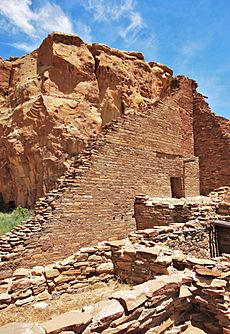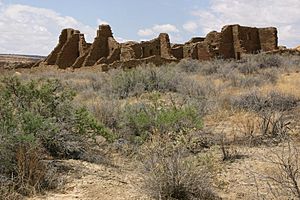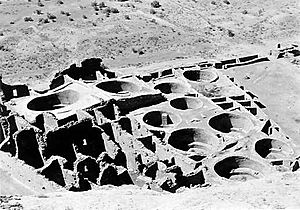Pueblo Bonito facts for kids
Quick facts for kids Pueblo Bonito |
|
|---|---|
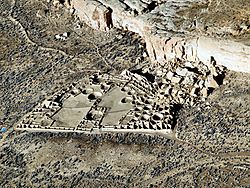
Aerial view, from the south
|
|
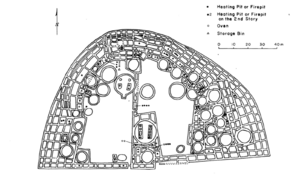
Site map
|
|
| Location | San Juan County, New Mexico, |
| First occupied | 828 |
| Built by | Chacoan civilization |
| Abandoned | 1126 |
| Governing body | Private |
| Lua error in Module:Location_map at line 420: attempt to index field 'wikibase' (a nil value). | |
Pueblo Bonito (which means beautiful town in Spanish) is a very famous and important ancient building. It is the largest "great house" found in Chaco Culture National Historical Park in northern New Mexico. People called Ancestral Puebloans built and lived in this huge structure. They occupied it between the years AD 828 and 1126.
The National Park Service says that Pueblo Bonito is the most studied and celebrated cultural site in Chaco Canyon. It was built in different stages from about AD 850 to AD 1150. This place was once the main center of the ancient Chacoan world. An expert named Brian Fagan even said that Pueblo Bonito is as famous as Stonehenge in England or Machu Picchu in Peru.
In 1941, a large part of the canyon wall fell. This section was known as Threatening Rock. It destroyed some of the back wall and several rooms of Pueblo Bonito. The ancient builders seemed to know about this danger. They still chose to build under the cracked stone. The wall was about 97 feet (30 meters) high and weighed around 30,000 tons. The Puebloans tried to make the structure stronger to support it.
In 2009, scientists found traces of cacao in pottery pieces at Pueblo Bonito. This cacao came from very far away, at least 1,200 miles (1,900 km). This discovery showed that cacao was brought into this area before the Spanish arrived around 1500. Cacao was important in ancient rituals. Special cylindrical pottery jars, common in Central America, were also found here. About 111 of these rare jars were found in Pueblo Bonito's 800 rooms.
Contents
Discovering Pueblo Bonito
A United States army officer, Lt. James H. Simpson, and his guide, Carravahal, found Chaco Canyon in 1849. This happened during a military trip. They quickly looked at eight large ruins in Chaco Canyon. Carravahal gave them their Spanish names, including Pueblo Bonito. Simpson later wrote the first description of Chaco Canyon. It included drawings by the expedition artist R. H. Kern.
Later, a rancher named Richard Wetherill and a student, George H. Pepper, started digging at Pueblo Bonito. They worked from 1896 to 1900. Two brothers, B. Talbot Hyde and Frederick E. Hyde, Jr., paid for these excavations. They were collectors from New York City. During this time, the men uncovered 190 rooms. They also took photos and made maps of all the main buildings.
Among the items found by Pepper were eight wooden flutes. These flutes were in a room Pepper called "Room 33." They are similar to Anasazi flutes, which are like early Native American flutes. The ancient people used special jars and ceramic burners for their rituals. The Hyde brothers gave the many artifacts they found to the American Museum of Natural History.
After the digging, Wetherill tried to own parts of Chaco Canyon. This included Pueblo Bonito. But the government took control of these lands in 1904. Wetherill had to stop his work. He continued to run a trading post there until he died in 1910.
What Pueblo Bonito Looks Like
Pueblo Bonito is split into two parts by a straight wall. This wall runs north to south through the middle courtyard. A large ceremonial room, called a Great Kiva, is on each side of this wall. This creates a balanced design, common in many "great houses." Besides the Great Kivas, over thirty other kivas or ceremonial areas were found. Many of these were also near the large central courtyard. The living spaces inside were quite big for ancient times.
The site covers about 3 acres (1.2 hectares). It has around 800 rooms. In some parts, the building was four or five stories high. Later, builders filled some lower rooms with dirt. This helped support the weight of the upper levels. The builders used strong masonry walls, up to 3 feet (0.9 meters) thick.
People have different ideas about how many people lived here. In the early 1900s, some thought thousands of people lived in every room. But newer studies suggest fewer than 800 people. This is because there are not many fireplaces found. One study based on the buildings estimated only about 12 families, or 70 people, lived there at its busiest time. These families likely lived on the ground floor, near the central courtyard. Rooms were connected by inside doorways, some shaped like a "T." A family might have used 3 to 4 rooms. Many small inner spaces were used for storage. There was usually no outside entrance to the room blocks, except from the central courtyard.
Some people think Pueblo Bonito was not a regular village or city. Even though it's big enough for many people, the area might not have supported a huge population. Digging at the site hasn't found much trash, which would be common in a busy living area. A popular idea is that Pueblo Bonito was a center for rituals and ceremonies. This is shown by the many kivas, which are often used for rituals. The way the site is built and how it connects to other Chaco Canyon sites also supports this idea. Even with many people visiting, only about 50-60 burials were found here.
The site shows that the Puebloans understood the sun and moon cycles. These cycles are marked in the rock carvings on nearby cliffs. They are also part of the design of Pueblo Bonito itself.
Scientists studied ancient pack rat nests. They found that when Pueblo Bonito was built, Chaco Canyon had many trees. These included ponderosa pines. Evidence of these trees can be seen in the building's support beams. Scientists believe that during the time people lived there, almost all the trees in the valley were cut down. They used the wood for building and for fuel. This cutting down of trees, along with a dry period, caused the water level in the valley to drop a lot. This made the land infertile. This helps explain why Pueblo Bonito was lived in for only about 300 years. It's a good example of how cutting down too many trees can harm the local environment. The Ancestral Puebloans could no longer grow enough food. So, they had to move away.
Starting in 2004, the University of New Mexico began new digs at Pueblo Bonito. They wanted to find new information. Most of the major digging in Chaco Canyon happened long ago. Because of this, we still don't fully understand the big changes that happened in Chaco Canyon.
A multi-year study focused on Pueblo Bonito. Its goal was to learn more about how people lived and worked there. The main aim of this new work is to find information that helps researchers understand how these "great house" communities grew. They want to see how changes in population related to how much food and goods they produced.
So far, the team has found thousands of artifacts. These include pottery, animal bones, and stone pieces. Because of their findings, the researchers received another grant. They will analyze over 300,000 artifacts. This is the largest collection of items ever found at a single site in Chaco.
Family History at Pueblo Bonito
Room 33 is one of the most studied areas of Pueblo Bonito. It was built during the earliest phase of the site in the 9th century. Many important burials were found in Room 33. These burials are different from others in Chaco Canyon. Most people were buried outside the great houses. The oldest burial was of a man who died violently. Archaeologists think Room 33 was built as a special burial place for him and his family members. He was buried with thousands of turquoise and shell beads. These were once necklaces, anklets, and bracelets. This made his burial the richest ever found in the Southwest.
Over the next 330 years, thirteen other people were buried in the same place. These included both men and women. They were buried with many valuable items. This suggests they had important roles in the community. Scientists studied their DNA. They found that nine of these people shared mitochondrial DNA. This means they were all related through their mothers. Archaeologists believe that Pueblo Bonito was linked to an important family line. This family inherited their status from their mothers, for about 330 years. This discovery is the first proof that Ancestral Puebloans passed down status through the mother's side. This is also a link to their modern Pueblo descendants. Many of them still follow this tradition today.
How Pueblo Bonito Was Built
An archaeologist named Mary Metcalf thinks it took about 805,000 hours of human work to build the main part of Pueblo Bonito. Imagine how many people worked together!
Ancient Rock Art
On the rock wall right behind Pueblo Bonito, there are many petroglyphs. These are images carved into the rock. Some show feet with six toes. This style is also seen in other ancient Pueblo rock art. These images were made in the late 900s or early 1000s.
See also
- The Mystery of Chaco Canyon a PBS documentary narrated by Robert Redford
 In Spanish: Pueblo Bonito para niños
In Spanish: Pueblo Bonito para niños


